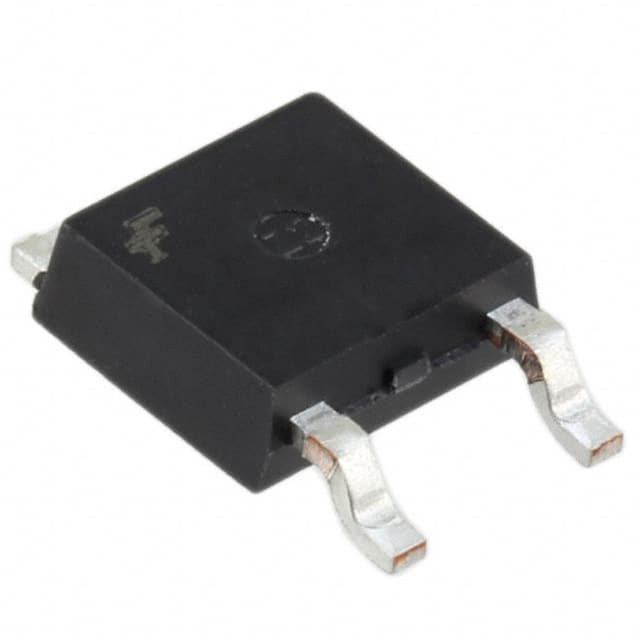Xem thông số kỹ thuật để biết chi tiết sản phẩm.

FQD5N30TF: Product Overview and Analysis
Introduction
The FQD5N30TF is a power MOSFET belonging to the category of electronic components. This device is widely used in various applications due to its unique characteristics and functional features. In this entry, we will provide an overview of the FQD5N30TF, including its basic information, specifications, pin configuration, functional features, advantages and disadvantages, working principles, application field plans, and alternative models.
Basic Information Overview
- Category: Electronic Components
- Use: Power MOSFET for electronic circuits
- Characteristics: High power handling capacity, low on-state resistance, fast switching speed
- Package: TO-252 package
- Essence: Efficient power management
- Packaging/Quantity: Typically available in reels or tubes containing multiple units
Specifications
- Voltage Rating: 300V
- Current Rating: 5A
- On-State Resistance (RDS(on)): 0.6 Ohms
- Gate Threshold Voltage: 2.5V
- Operating Temperature Range: -55°C to 150°C
- Package Type: TO-252 (DPAK)
Detailed Pin Configuration
The FQD5N30TF features a standard TO-252 pin configuration with three pins: 1. Pin 1 (Gate): Input for controlling the switching operation 2. Pin 2 (Drain): Connection to the load or power supply 3. Pin 3 (Source): Ground reference for the device
Functional Features
- High Power Handling: Capable of handling high current and voltage levels
- Low On-State Resistance: Minimizes power loss and heat generation
- Fast Switching Speed: Enables rapid switching in electronic circuits
Advantages and Disadvantages
Advantages
- Efficient power management
- Suitable for high-frequency applications
- Compact TO-252 package for space-constrained designs
Disadvantages
- Sensitive to static discharge
- Limited voltage and current ratings compared to higher-power devices
Working Principles
The FQD5N30TF operates based on the principle of field-effect transistors, where the gate voltage controls the flow of current between the drain and source terminals. By modulating the gate voltage, the device can switch between conducting and non-conducting states, enabling efficient power control in electronic circuits.
Detailed Application Field Plans
The FQD5N30TF finds extensive use in various electronic applications, including: - Switching power supplies - Motor control circuits - LED lighting systems - Audio amplifiers - DC-DC converters
Detailed and Complete Alternative Models
Several alternative models to the FQD5N30TF include: - IRF530N - STP5NB60FP - FQP5N50C - NDP6020P
In conclusion, the FQD5N30TF power MOSFET offers a balance of performance and compactness, making it suitable for a wide range of electronic applications. Its specifications, functional features, and application versatility make it a valuable component in modern electronic designs.
Word Count: 410
Liệt kê 10 câu hỏi và câu trả lời thường gặp liên quan đến ứng dụng FQD5N30TF trong giải pháp kỹ thuật
What is FQD5N30TF?
- FQD5N30TF is a MOSFET (Metal-Oxide-Semiconductor Field-Effect Transistor) used in electronic circuits for switching and amplification.
What are the key specifications of FQD5N30TF?
- FQD5N30TF has a voltage rating of 300V, a current rating of 5A, and a low on-resistance for efficient power handling.
How can FQD5N30TF be used in motor control applications?
- FQD5N30TF can be used to control the speed and direction of DC motors by acting as a switch in the motor control circuit.
In what types of power supply designs can FQD5N30TF be utilized?
- FQD5N30TF can be used in switch-mode power supplies (SMPS) and other power management circuits to regulate and control the flow of power.
What are the thermal considerations when using FQD5N30TF in high-power applications?
- Proper heat sinking and thermal management are essential to ensure that FQD5N30TF operates within its temperature limits in high-power applications.
Can FQD5N30TF be used in audio amplifier circuits?
- Yes, FQD5N30TF can be employed in audio amplifier designs to control the flow of current and manage power distribution.
What are the typical applications for FQD5N30TF in automotive electronics?
- FQD5N30TF can be used in automotive systems for controlling lighting, motors, and other electronic components due to its high voltage and current capabilities.
How does FQD5N30TF contribute to energy efficiency in electronic systems?
- By minimizing on-resistance and efficiently managing power flow, FQD5N30TF helps improve the energy efficiency of electronic systems.
Are there any specific layout considerations when integrating FQD5N30TF into a PCB design?
- Proper attention to layout, including minimizing parasitic resistance and inductance, is important to optimize the performance of FQD5N30TF in a PCB design.
What are the common failure modes of FQD5N30TF and how can they be mitigated?
- Common failure modes include overcurrent, overvoltage, and thermal stress. These can be mitigated through proper circuit protection, voltage regulation, and thermal management techniques.

